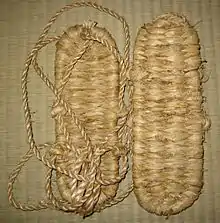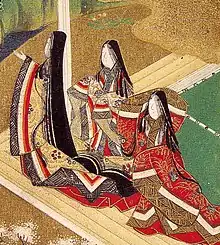Waraji
Waraji (草鞋) are sandals made from straw rope that were the standard footwear of the common people in Japan.

Use
Waraji resemble other forms of traditional Japanese footwear, such as zōri and geta, with a few key differences. Waraji, due to their historically low-class nature, are considered to be a very informal type of footwear, and are not worn with formal kimono. They are typically not worn with tabi socks, and are woven so that the wearer's toes protrude slightly over the edge of the shoe, a feature not seen in either zōri or geta.
In modern day Japan, waraji are mainly worn by Buddhist monks, with zōri and geta being worn far more commonly by the general population.
Tying
Historically, there were a number of different ways of tying waraji straps, with their being no standardised method of attaching the shoes to one's feet.
Gallery
 Pairs of waraji hanging on a building
Pairs of waraji hanging on a building A single pair of waraji
A single pair of waraji.png.webp) Samurai putting on waraji
Samurai putting on waraji
